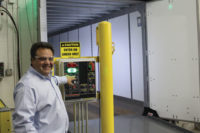Earlier this year, Industrial Safety & Hygiene News surveyed 2,000 readers on how they use computers in their jobs. 541 readers responded, for a 27 percent response rate. Whether you are wondering how many of your colleagues are jumping onto the information highway or what percentage use CD-ROM drives, the results will interest you.
The basics
Virtually all readers use a computer at work, with the majority (92 percent) using IBM-compatible PCs. 74 percent of readers are doing their work on desktop computers. The results also suggest that a sizeable number of readers are also bringing their work on the road or taking it home with them; 23 percent of those responding say they use a laptop computer in addition to a desktop unit.Safety pros are also getting wired at home in great numbers. 76 percent say they use a computer at home. And of those who don't, 38 percent say they plan to purchase a home computer this year.
Improving their computer knowledge is also a goal of most readers. 73 percent say they plan to take classes or read books this year to enhance their computer skills in 1995.
CD-ROM usage: 52 percent of readers say their computers have a CD-ROM drive. And nearly half (41 percent) of those without a CD-ROM drive say they plan to buy one in 1995. 32 percent say they use CDs for regulatory information searches. And nearly one in four (24 percent) access MSDSs on CD-ROM.
Getting connected
More than a third of respondents (36 percent) say they've traveled the information highway, spending time on the Internet or other online services regularly. Look for that number to keep growing. 56 percent say their computers have a modem. Nearly one-quarter (24 percent) of those without modems say they plan to purchase one in 1995.
What are people tapping into? 17 percent of readers say they connect to one of the commercial services regularly (CompuServe, America Online, and Prodigy). 16 percent regularly spend time on the Internet, and 13 percent visit the Labor department's electronic bulletin board.
Readers use these online resources in a variety of ways. 22 percent exchange e-mail over these networks. 26 percent use the technology to access news and other reference information. A small percentage (13 percent) also look for experts online to answer questions. 18 percent also download files.
Most readers only spend a few hours a week online. 44 percent are online 1-2 hours. 28 percent are connected for 3 to 5 hours, and 12 percent spend 6 to 10 hours online. There are also a few cyber-surfers (11 percent) spending 16 or more hours online.
Optimistic but...
EH&S pros have mixed feelings about this changing electronic world. Readers see great potential to locate and sort through information easily and quickly. They comment on the potential for a 'greater sharing of ideas' and the 'instant access to unlimited amounts of information'They also point to a range of drawbacks accompanying this information revolution. A common criticism is the lack of human interaction. One reader talks about how easy it can be to get immersed in work on the computer and 'lose touch with people.' Another says reliance on the computer could 'detract from your personal skills.' 'The personal touch is still important,' writes another. Some readers also feel the technology could cut down on the amount of 'life experience ' that can occur among safety pros.
Another common concern is the fear of information overload. One reader who spends time on the Internet says 'the amount of information can be overwhelming.'
Some readers say users can put too much stock in the value of a computer. 'The computer is not always the fastest way: the PPE permeation guide and the NIOSH pocket guide are fast and easy in paper form,' writes one respondent.
The learning curve is another negative that survey respondents point to. They talk about the cost and time required to tap into some of these technologies such as the Internet or CD-ROM. 'Learning new systems takes time,' writes one reader. Several respondents also mention the challenges of getting 'old-fashioned employees' up to speed on these changes.
Other concerns readers point to include computer networks crashing, convincing management of the benefits, computer viruses and network security breaches, and the expenses.
